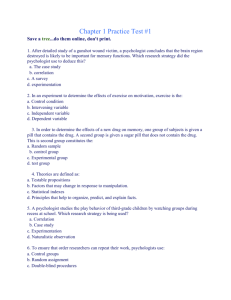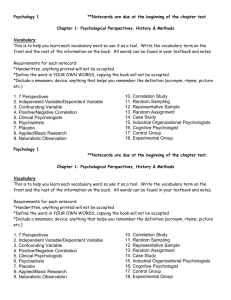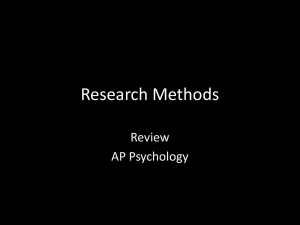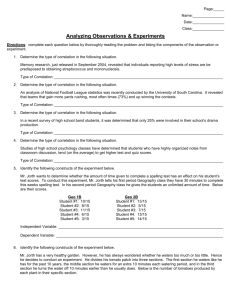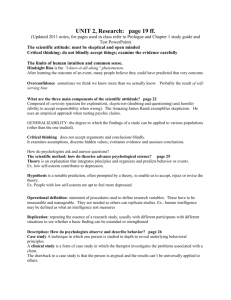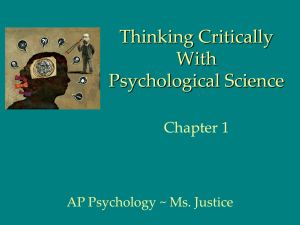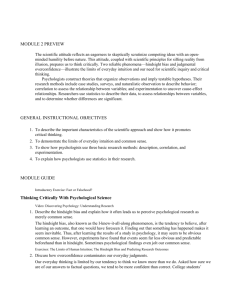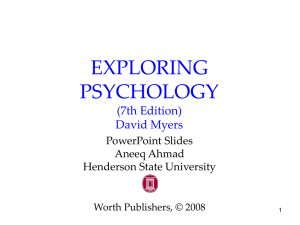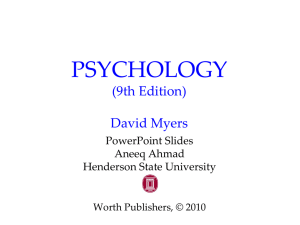module 3 Research Strategies: How Psychologists Ask and Answer
advertisement
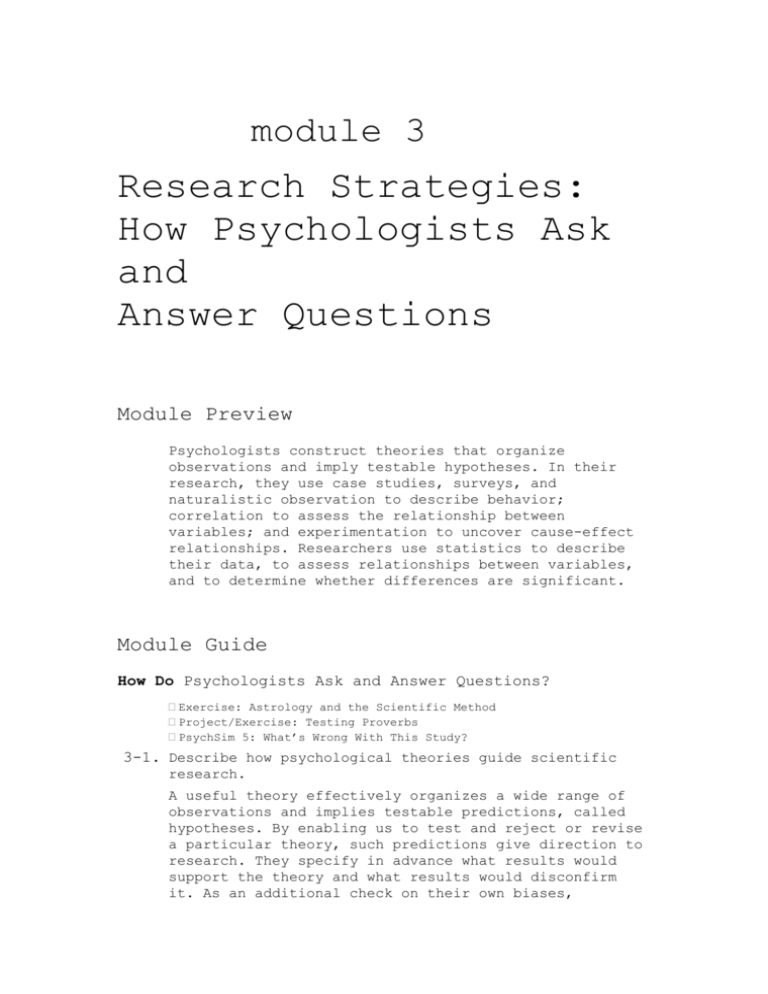
module 3 Research Strategies: How Psychologists Ask and Answer Questions Module Preview Psychologists construct theories that organize observations and imply testable hypotheses. In their research, they use case studies, surveys, and naturalistic observation to describe behavior; correlation to assess the relationship between variables; and experimentation to uncover cause-effect relationships. Researchers use statistics to describe their data, to assess relationships between variables, and to determine whether differences are significant. Module Guide How Do Psychologists Ask and Answer Questions? Exercise: Astrology and the Scientific Method Project/Exercise: Testing Proverbs PsychSim 5: What’s Wrong With This Study? 3-1. Describe how psychological theories guide scientific research. A useful theory effectively organizes a wide range of observations and implies testable predictions, called hypotheses. By enabling us to test and reject or revise a particular theory, such predictions give direction to research. They specify in advance what results would support the theory and what results would disconfirm it. As an additional check on their own biases, psychologists report their results precisely with clear operational definitions of concepts. Such statements of the procedures used to define research variables allow others to replicate, or repeat, their observations. Often, research leads to a revised theory that better organizes and predicts observable behaviors or events. Lectures: Case Studies; Surveys, Evaluation Apprehension, and Naturalistic Observation; Predicting Elections; Survey Research and Random Samples Exercises: The Wording of Survey Questions; Conducting a National Survey; Choosing a Random Sample Project/Exercise: Naturalistic Observation in the Dining Hall 3-2. Compare and contrast case studies, surveys, and naturalistic observation, and explain the importance of random sampling. The case study is the method by which psychologists analyze one or more individuals in great depth in the hope of revealing things true of us all. While individual cases can suggest fruitful ideas, any given individual may be atypical, making the case misleading. The survey looks at many cases in less depth and asks people to report their behavior or opinions. Asking questions is tricky because even subtle changes in the order or wording of questions can dramatically affect responses. In everyday experience, we are tempted to generalize from a few vivid but unrepresentative cases. The survey ascertains the self-reported attitudes or behaviors of a population by questioning a representative, random sample. Naturalistic observation consists of observing and recording the behavior of organisms in their natural environment. Like the case study and survey methods, this research strategy describes behavior but does not explain it. Exercises: Correlation and Predicting Exam Performance; Correlating Test-Taking Time and Performance; Illusory Correlation; The Gambler’s Fallacy Lectures: Understanding Correlation; Misinterpreting Correlations; Extraordinary Events and Chance: Your Birth Date in Pi? Project: Evaluating Media Reports of Research PsychSim 5: Statistics: Correlation 3-3. Describe positive and negative correlations, and explain how correlational measures can aid the process of prediction but not provide evidence of cause-effect relationships. When surveys and naturalistic observations reveal that one trait or behavior accompanies another, we say the two correlate. A correlation coefficient is a statistical measure of relationship. A positive correlation indicates a direct relationship, meaning that two things increase together or decrease together. A negative correlation indicates an inverse relationship: As one thing increases, the other decreases. Researchers depict scores on graphs called scatterplots; each point plots the value of two variables. The correlation coefficient helps us to see the world more clearly by revealing the extent to which two things relate. Perhaps the most irresistible thinking error is to assume that correlation proves causation. Correlation reveals how closely two things vary together and thus how well one predicts the other. However, the fact that events are correlated does not mean that one causes the other. Thus, while correlation enables prediction, it does not provide explanation. 3-4. Describe how people form illusory correlations, and explain the human tendency to perceive order in random sequences. Illusory correlation, the perception of a relationship where none exists, often occurs because our belief that a relationship exists leads us to notice and recall confirming instances of that belief. Because we are sensitive to unusual events, we are especially likely to notice and remember the occurrence of two such events in sequence, for example, a premonition of an unlikely phone call followed by the call. Illusory correlation is also a result of our natural eagerness to make sense of our world. Given even random data, we look for meaningful patterns. We usually find order because random sequences often don’t look random. Apparent patterns and streaks (such as repeating digits) occur more often than people expect. Failing to see random occurrences for what they are can lead us to seek extraordinary explanations for ordinary events. Lecture: Description, Prediction, Explanation Exercise: Introducing the Experiment; Random Assignment; Main Effects and Interactions or “It All Depends” Project/Exercise: The Placebo Effect Videos: Program 1 of Moving Images: Exploring Psychology Through Film: The Scientific Attitude: Testing Therapeutic Touch; Module 3 of Psychology: The Human Experience: Experimental Design; Segment 1 of the Scientific American Frontiers series, 2nd ed.: Tackling a Killer Disease Instructor Video Tool Kit: Schachter’s Affiliation Experiment; Does Self-Confidence Intimidate Others? 3-5. Explain how experiments help researchers isolate cause and effect, focusing on the characteristics of experimentation that make this possible. The experiment is a research method in which the investigator manipulates one or more factors to observe their effect on some behavior or mental process, while controlling other relevant factors. If a behavior changes when we vary an experimental factor, then we know the factor is having a causal effect. In many experiments, control is achieved by randomly assigning people either to an experimental group, which is exposed to the treatment, or a control group, which is not exposed. Often, the research participants are blind (uninformed) about what treatment, if any, they are receiving. One group might receive the treatment, while the other group receives a placebo (a pseudotreatment). Often, both the participant and the research assistant who collects the data will not know which condition the participant is in (the double-blind procedure). The placebo effect is well documented. Just thinking one is receiving treatment can lead to symptom relief. The independent variable is the experimental factor that is manipulated. It is the variable whose effect is being studied. The dependent variable is the variable that may change in response to the manipulations of the independent variable. It is the outcome factor. Statistical Reasoning in Everyday Life Exercise: Teaching Statistical Concepts Using Space and Students’ Bodies Exercise/Project: Describing Data Project: Organizing and Interpreting Data PsychSim 5: Descriptive Statistics 3-6. Explain the importance of statistical principles, and give an example of their use in everyday life. Statistics help us to organize, summarize, and make inferences from data. They help us see and interpret what the unaided eye might miss. Statistical principles enable us to evaluate big, round, undocumented numbers that often misread reality and mislead the public. 3-7. Describe the three measures of central tendency, and tell which is most affected by extreme scores. The mode is the most frequently occurring score in a distribution. The mean is the arithmetic average of a distribution, obtained by adding the scores and then dividing by the number of scores. If the distribution is skewed by even a few extreme scores, the mean will be biased. The median is the middle score in a distribution; half the scores are above it and half are below it. 3-8. Describe two measures of variation. The range of scores—the gap between the lowest and highest score—provides only a rough estimate of variation. The more standard measure of how scores deviate from one another is the standard deviation. It better gauges whether scores are packed together or dispersed because it uses information from each score. Many types of scores are distributed along a bellshaped curve, or a normal curve. Lectures: The Power of Vivid Cases; The Law of Large Numbers and the Gambler’s Ruin; Differences Between Groups Exercises: An M&M’s Sampling Demonstration; The Birthday Coincidence and Other Remarkable Facts; More Cases Are Better Than Fewer; Sample Size Project: Statistics and Consumer-Oriented Research 3-9. Identify three principles for making generalizations from samples. Important principles to remember in making generalizations include the following. a. Representative samples are better than biased samples. We are particularly prone to overgeneralize from vivid cases at the extremes. b. Less-variable observations are better than those that are more variable. Averages are more reliable when derived from scores with low variability. c. More cases are better than fewer. Small samples provide less reliable estimates of the average than do large samples. Exercise/Projects: When Is a Difference Significant? 3-10. Explain how psychologists decide whether differences are meaningful. Psychologists use tests of statistical significance to help them determine whether differences between two groups are reliable. When the averages of the samples drawn from the groups are reliable, and the difference between them is relatively large, we say the difference has statistical significance. This means that the difference very likely reflects a real difference and is not due to chance variation between the samples. Given large enough or homogeneous enough samples, a difference between them may be statistically significant yet have little practical significance.
